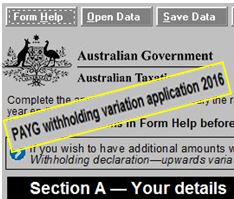 Owning an investment property can be a burden on your cash flow, especially when you have more than one property. With loan repayments, council and water rates, insurances, repairs and maintenance and property agent fees, many times the rent you receive won’t cover these expenses. The real pressure is felt when interest rates rise or worse yet, a tenant moves out. The best way you can combat this pressure is to prepare a PAYG Withholding Variation.
Owning an investment property can be a burden on your cash flow, especially when you have more than one property. With loan repayments, council and water rates, insurances, repairs and maintenance and property agent fees, many times the rent you receive won’t cover these expenses. The real pressure is felt when interest rates rise or worse yet, a tenant moves out. The best way you can combat this pressure is to prepare a PAYG Withholding Variation.
The PAYG Withholding Variation has been known by many names, most notably a Section 221D and a 1515. It is highly possible that this was a deliberate tact from the Australian Taxation Office (ATO) to give it a technical name so property investors don’t uncover the benefits. Effectively what a Variation does is vary your tax rate therefore providing you with additional cash flow with your periodic pay.
Property investors that currently do not prepare a Variation will be used to getting larger refunds when they lodge their tax returns. This is because the tax benefits of having a negatively geared property are not crystallised until the tax return is lodged. While many like getting this bonus at year end, it is not necessarily the smartest way of using your tax refund.
The smarter way to look at this kind of refund is see that it is effectively an interest free loan to the ATO for twelve months. By putting a Variation in place, you will not receive the bigger refunds, however you will be able to use the additional cash each week to reduce a mortgage or pay other property related expenses.
A PAYG Withholding Variation application is effectively a forecast of your entire income and expenses for the upcoming financial year. By engaging your accountant’s services, they will calculate what your estimated taxable income will be and lodge the Variation with the ATO. The ATO will then inform you and your payroll office of what the varied tax rate will be. It’s important to note that this process must happen each year, just as you do your tax return every year.
An example of how this works would be; Tom has a gross salary of $80,000. After tax and no net property losses, he will have approximately $60K in take-home pay for the year or $5,000 per month. With two properties and combined net property losses of $20,000, provided a Variation is prepared, Tom will receive an additional $8,000 over the financial year that he would’ve otherwise received as a tax refund via his tax return. This works out to be an additional $667 per month or a total of $5,667 per month take-home pay. The extra money can be used to pay bills or as a buffer for a rainy day. A popular strategy is to use the additional cash to pay down existing debt or alternatively deposit it into an offset account for it to be accessed at a later date.
The important thing to remember is that if your circumstances change during the year, the Variation will need to be updated. This can be updated as many times as required.
The PAYG Withholding Variation has been around for a long time but has been underutilised by many taxpayers with negatively geared properties. By now understanding the benefits, you would be crazy to not get one prepared today.

David Shaw is the CEO of WSC Group: Certified Practising Accountants and Business Advisors, and
was voted Property Tax Specialist of the Year in the Your Investment Property 2013 Readers Choice Awards (as well as runner up in 2012, 2014 & 2015).
*The advice published on social media mediums by WSC Group is of a general nature and does not constitute specific financial advice. For a detailed financial strategy you should consult with a qualified financial advisor before making any investment decision.
Disclaimer: while due care is taken, the viewpoints expressed by contributors/sponsors do not necessarily reflect the opinions of Your Investment Property.

